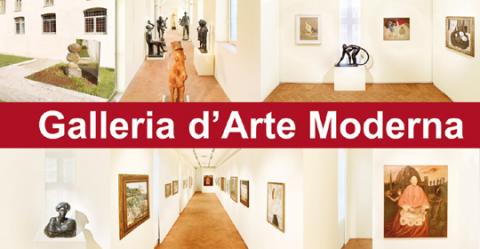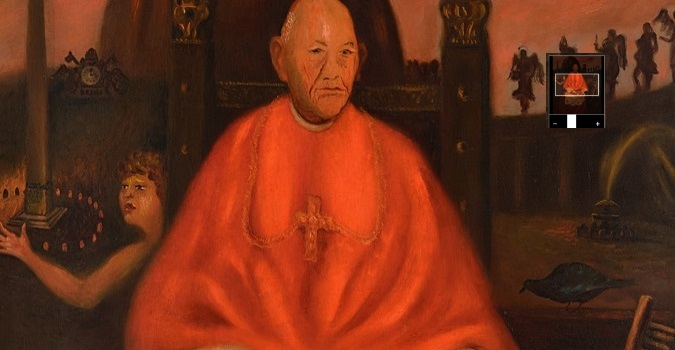Presentation of the museum
The Galleria d'Arte Moderna, after being closed for a period of time in order to be able to offer the public and the students, but also the large groups of tourists and travellers who visit this part of the city's historic centre, its precious collection of artworks from the end of the nineteenth century to the first half of the twentieth century, selected and reassembled from time till time thanks to the thematic exhibitions that have characterised GAM's most recent history.

The collection was created in 1925 with the intention and aim to record the Roman cultural and artistic landscape in its various aspects and today, after several purchases, it contains more than 3000 paintings, sculptures and graphics: a truly special collection of great value for the comprehension of the development of the visual arts in Italy in the 19th and 20th centuries. Among the most representative names, for the 19th century, Giulio Aristide Sartorio, Nino Costa, Onorato Carlandi and the painters of the "XXV della Campagna Romana"; for the 20th century, divisionismo Romano with artworks by Armando Spadini, Camillo Innocenti, Arturo Noci, Giacomo Balla; the artworks of the 1930s and the artists of the Scuola Romana including Scipione, Mario Mafai, Giuseppe Capogrossi, Emanuele Cavalli. Emblematic works such as Il Cardinal Decano di Scipione, from 1930, are displayed in addition to numerous examples of the artistic trends of the century: from the 20th century to Realismo Magico, from Secondo Futurismo to École de Paris. The exhibition also includes sculpture, with artworks by Arturo Martini, Marino Marini and Giacomo Manzù, and the important work of Giulio Turcato's Comizio, purchased in the 1990s.
The city collection has been located in 1995 in its current home in Via Crispi, in the former late 16th century convent of the Carmelitane Scalze di San Giuseppe in Capo le Case. Due to the historical nature of the building and the small size of the spaces, as well as the needs related to the institutional programme of temporary exhibitions, the collection is exhibited in rotation, according to specific and always different thematic itineraries. In the sculpture cloister surrounding the inner courtyard and in some of the spaces on the upper floors, a selection of sculptural works from the period 1880-1950 is always on display.
Some of the most important exhibitions that have considered the artworks in the collection according to original iconographic and thematic approaches include: Luoghi, figure, nature morte. Artworks from the Galleria d'Arte Moderna di Roma Capitale (November 2011 - December 2012); Legami e corrispondenze. Immagini e parole attraverso il '900 romano (February 2013 - April 2014); Artiste del Novecento tra visione e identità ebraica (June - October 2014); Artisti dell'Ottocento: temi e riscoperte (November 2014 - November 2015); Affinità elettive. Da de Chirico a Burri (December 2015 - March 2016); Roma Anni Trenta. La Galleria d'Arte Moderna e le Quadriennali d'Arte 1931 - 1935 - 1939 (March - December 2016); Stanze d'artista. Capolavori del '900 italiano (April - October 2017); Roma città moderna. Da Nathan al Sessantotto (March - December 2018); Donne. Corpo e immagine tra simbolo e rivoluzione (January - November 2019); Shepard Fairey. 3 Decades of Dissent (September - November 2020); Ciao Maschio. Volto potere identità dell'uomo contemporaneo (June - November 2021).
Important monographic exhibitions dedicated to the Masters present in the collection should also not be forgotten: Poesia della natura. Acquerelli di Onorato Carlandi dalle collezioni della Galleria Comunale d'Arte Moderna (March - October 2011); Libero De Libero e gli artisti della Cometa (January - April 2014); Arturo Noci (1874-1953). Figure e ritratti degli anni romani (June - November 2015); Mimì Quilici Buzzacchi. Tra segno e colore (September - December 2016); Giovanni Prini. Il potere del sentimento (December 2016 - March 2017); L'essenziale verità delle cose. Francesco Trombadori (October 2017 - March 2018).
Thanks to this choice of exhibition, the museum is always innovating, not only developing its own collection but also exploring the contemporary art scene, proposing new and stimulating reflections on the city's heritage and outlining new possible narratives. Some exhibitions - and in particular Le altre Opere. Artisti che collezionano artisti (February - May 2021) and Materia Nova. Roma - Ultime generazioni a confronto (December 2021-April 2022) - have had a highly experimental, research-based approach to the territory and the city of Rome. As indeed must be the mission of a public museum linked to a local institution.
The structure of the museum areas also allows the use of the cloister-garden for evocative tributes to the protagonists of the international scene (project From La Biennale di Venezia & OPEN to Rome) and site-specific installations (Sten-Lex. Rinascita, September 2020 - May 2022).
Thus, almost a century after its foundation, the Galleria d'Arte Moderna represents a precious new element in the extensive and detailed panorama of the Capital's museum offer, with a creative approach to its original and particular mission of looking at the contemporary art scene with a scientific and research-based approach, a strong focus on the city of Rome and an attentive and inclusive gaze, balanced between the preservation and enhancement of a priceless collection and the bold exploration of the present, between tradition and the future.






































